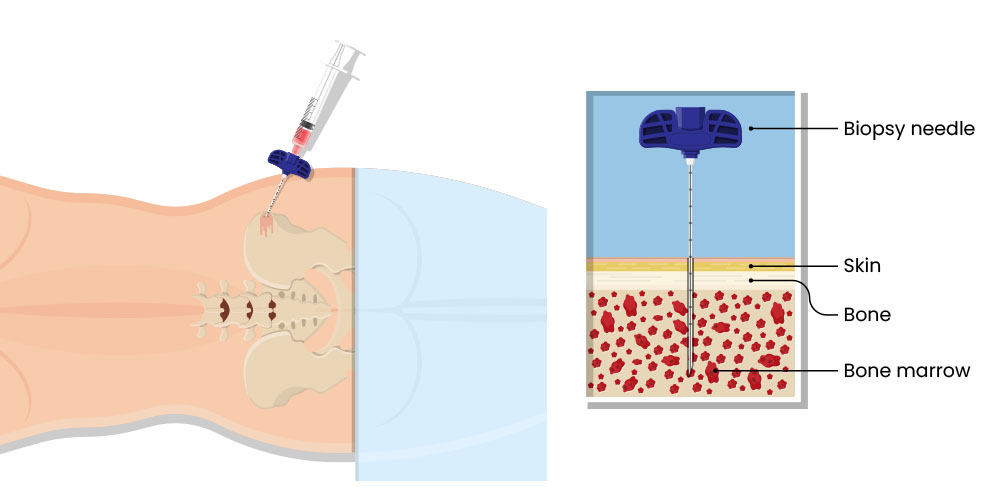Bone marrow biopsy Whakamātaunga mongamonga
A bone marrow biopsy takes a small sample of bone marrow and looks at it under a microscope to see if anything is wrong. The test helps to confirm your diagnosis and plan any treatment. The sample is usually taken from the back of your hip bone. It can be taken from your breastbone, but this is rare.
When you would have a bone marrow biopsy
A specialist might organise a bone marrow biopsy if they have concerns you might have:
- blood disorders, such as anaemia
- cancers, such as leukemia and lymphoma.
It may also be done to monitor the course of a disease.
Having a bone marrow biopsy
The biopsy will be done by a member of your specialist's team. They will explain the test to you. It takes 20 to 30 minutes to complete, so it is a good idea to go to the toilet beforehand.
You will need to lie on your side for the sample to be taken. The skin over your hip bone will be cleaned. You will be given a local anaesthetic to numb the area.
A small needle will then be passed through your skin and into your bone. A sample of your bone marrow fluid will be drawn up into the syringe. This is called bone marrow aspiration.
You may need a small piece of bone marrow removed. This is called a trephine biopsy. A special type of needle is used to do this. The needle is passed through your skin and into your bone and then gently turned back and forth. A small piece of bone marrow comes out when the needle is removed.
Your bone marrow sample will be sent to a laboratory where a specialist doctor will examine it under a microscope.
If you find the procedure too painful, you may be given laughing gas (nitrous oxide) to help you relax and to provide pain relief. If this happens, you should not drive for the rest of the day. If possible, it is best to arrange for someone else to drop you off and pick you up, whether or not the gas is used.
What a bone marrow biopsy looks like

Cultural needs
For some people, it is important to have their bone marrow sample returned to them after it has been tested.
For example, many Māori choose to have their bone marrow returned. This is so it can be blessed and buried in a significant place.
If the laboratory needs all of the bone marrow for their tests, it may not be possible to return it.
Let the hospital know in advance if having your bone marrow returned is important to you.
Additionally, let the hospital know if you would like:
- an interpreter
- a karakia during the procedure
- support from a Māori health worker
- to request either a female or a male doctor
- more information before your procedure.
Before your bone marrow biopsy
If you are taking blood thinners (such as warfarin), you will usually need to stop taking them for 2 to 5 days before your biopsy. Your specialist will advise you.
You can eat and drink as normal, unless you are having an intravenous sedation (medicine is inserted into your vein using a small needle).
Contact the hospital if you have not received instructions on how to prepare for your biopsy.
After your bone marrow biopsy
After your biopsy, you:
- will need to lie on a bed where nurses will watch you for around half an hour to make sure you are okay to go home
- may have a bruise and feel uncomfortable for a few days.
Taking mild pain relief such as paracetamol may help. Talk to your specialist or healthcare provider about this.
Results of your bone marrow biopsy
It can take a few weeks for the results of your bone marrow biopsy to come through. When your results are available, your specialist will advise you of them.
Risks of having a bone marrow biopsy
You may get some minor bleeding from the biopsy site. Your nurse will make sure this has stopped before you leave the hospital.
There is a small risk that the biopsy site will become infected. Before you leave the hospital, you will be given information on what to watch out for and what to do.
Contact the hospital or your healthcare provider if:
- you feel unwell
- have a fever (temperature over 38°C)
- have any other concerns related to the biopsy.
Informed consent
Healthcare services may be provided to you only if you make an informed choice and give informed consent to it. This forms part of your rights (Rights 5, 6 and 7) under the Code of Health and Disability Services Consumer Rights (the Code).
![]() The Code and Your Rights/Ōu Mōtika — Health & Disability Commissioner
The Code and Your Rights/Ōu Mōtika — Health & Disability Commissioner
The 3 rights that together allow for informed consent are:
- Right 5 — the right to effective communication
- Right 6 — the right to be informed
- Right 7 — the right to choice and consent.
This means you must be told about the service being suggested, including any risks or possible complications. You must have the chance to ask as many questions as you need to understand the information you are given.
You also have the right to have someone with you to help you. But the decision to say 'yes' or 'no' must be yours (unless you are unable to make that decision due to illness or other impairment, or sometimes in an emergency).
You also have the right to be given the information in a language you fully understand. You can ask for an interpreter if you need one.